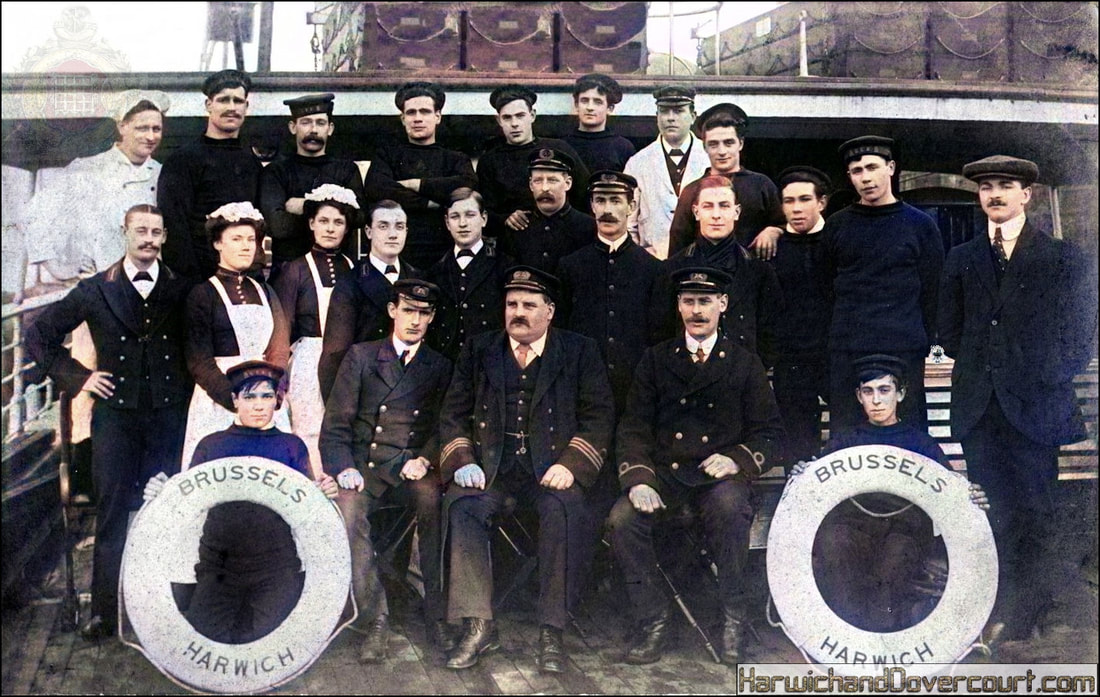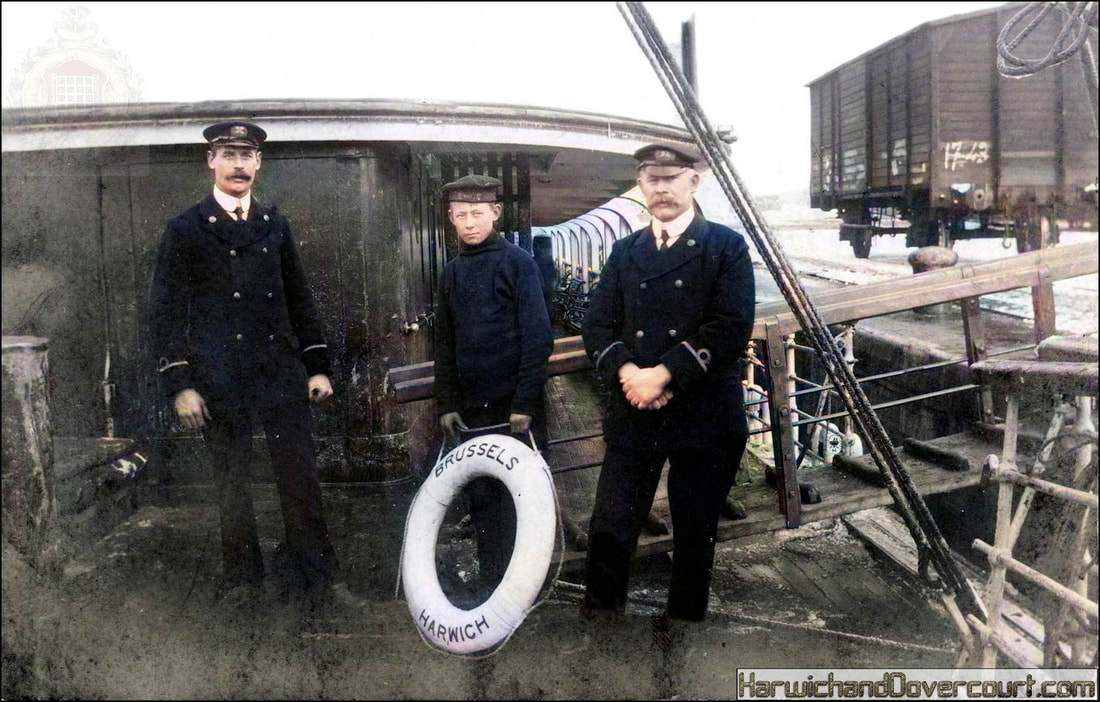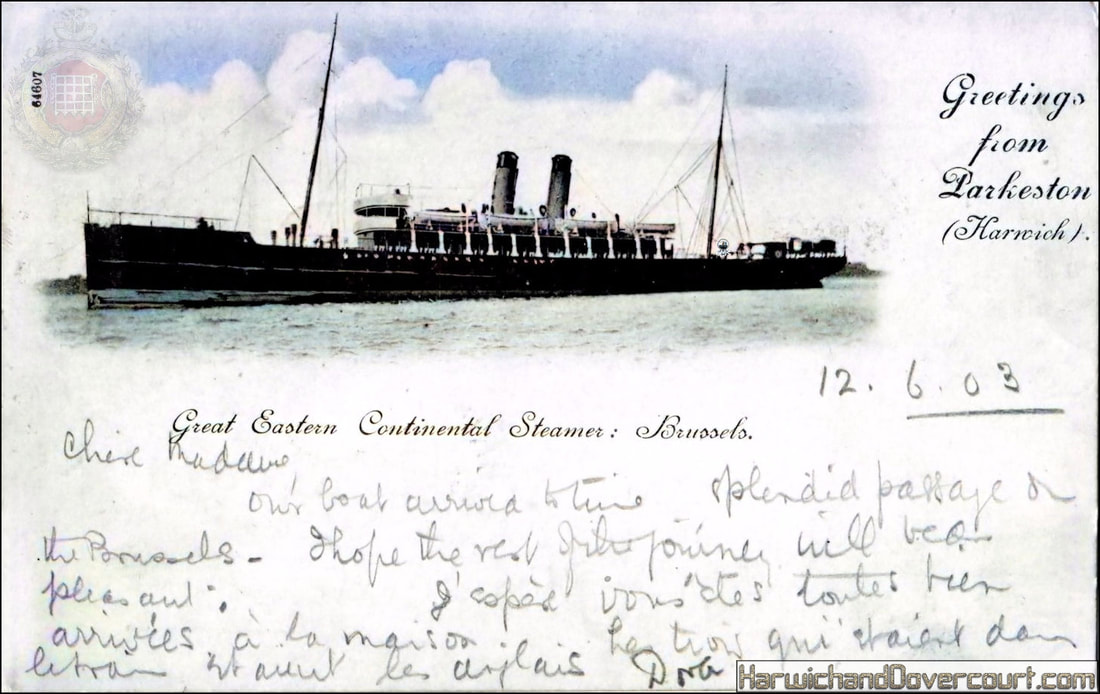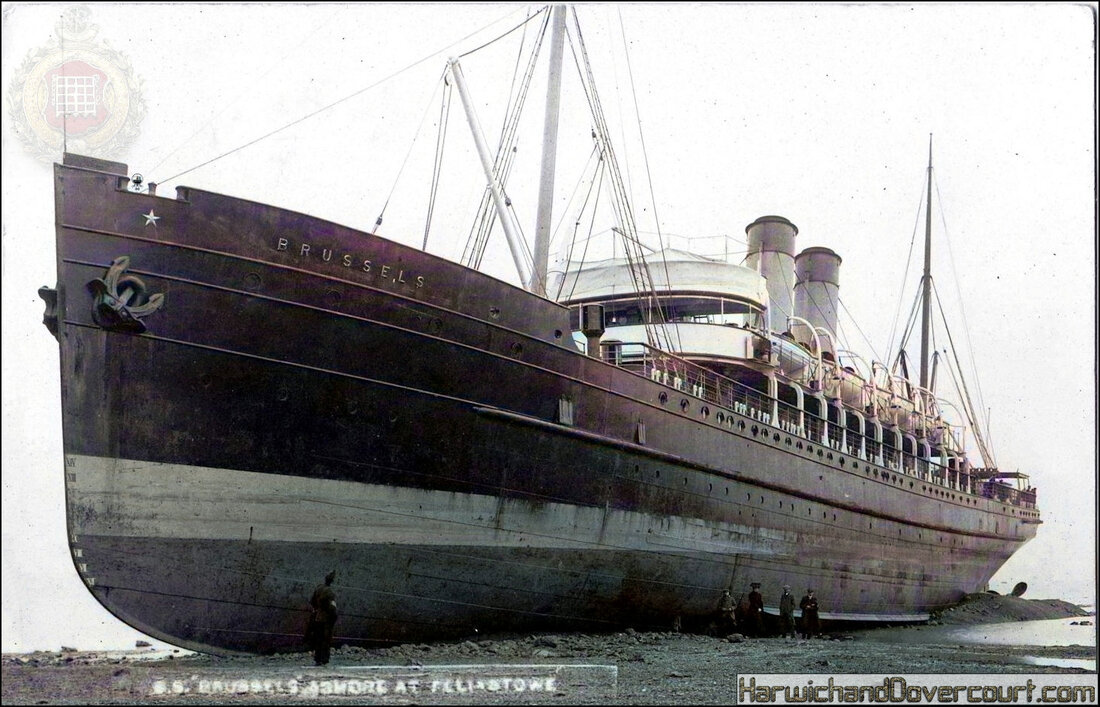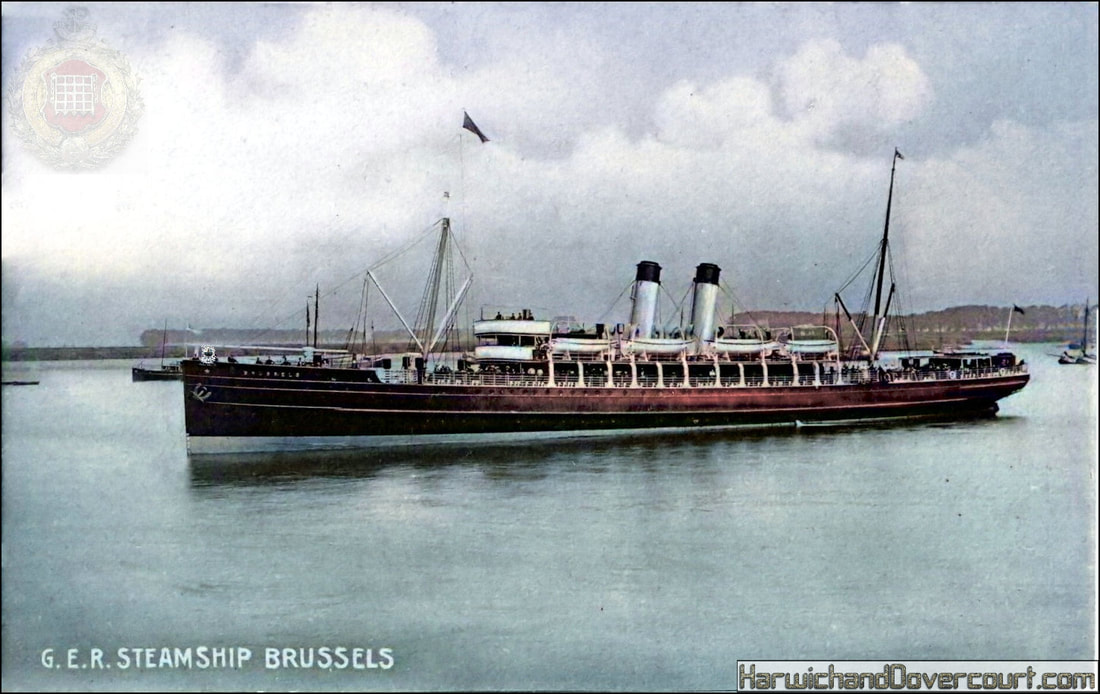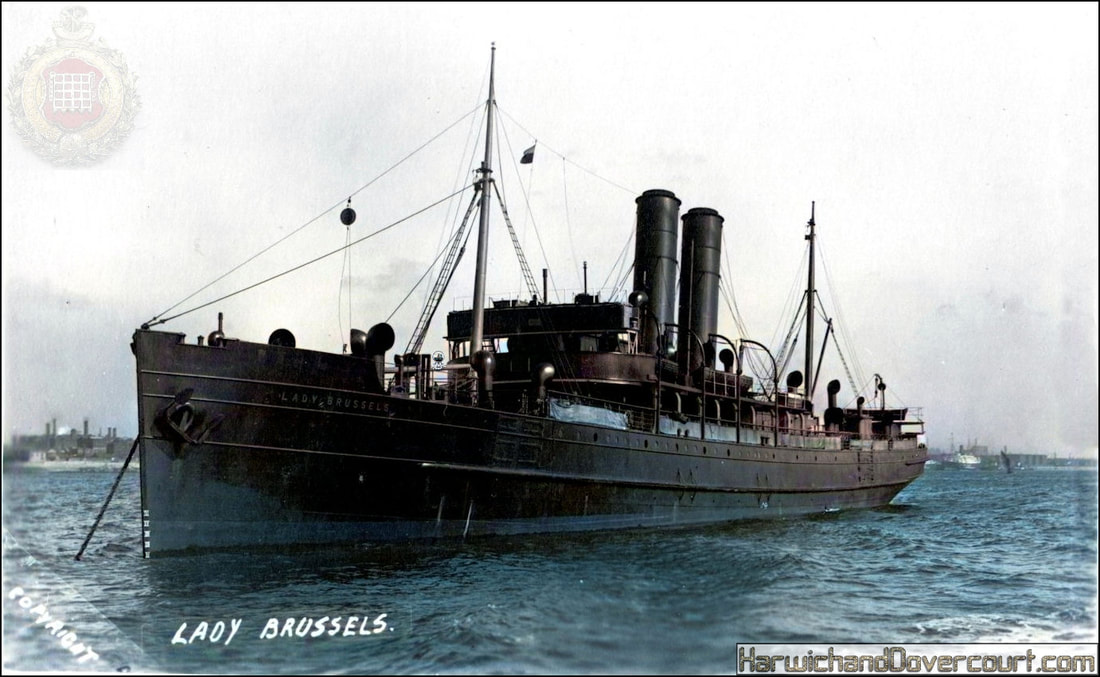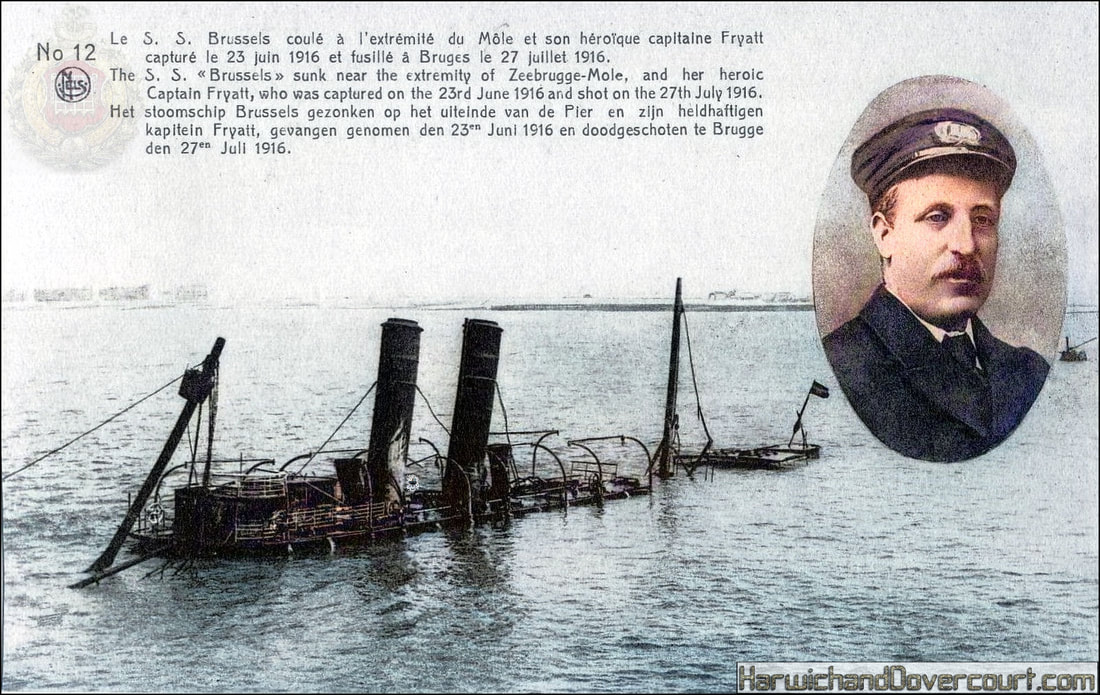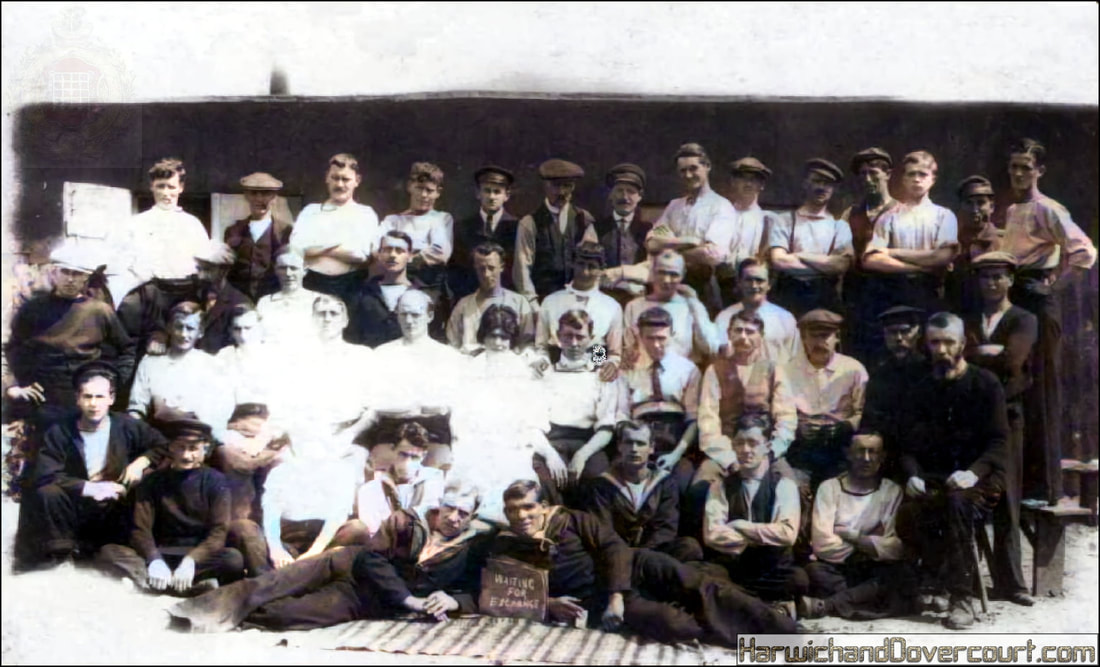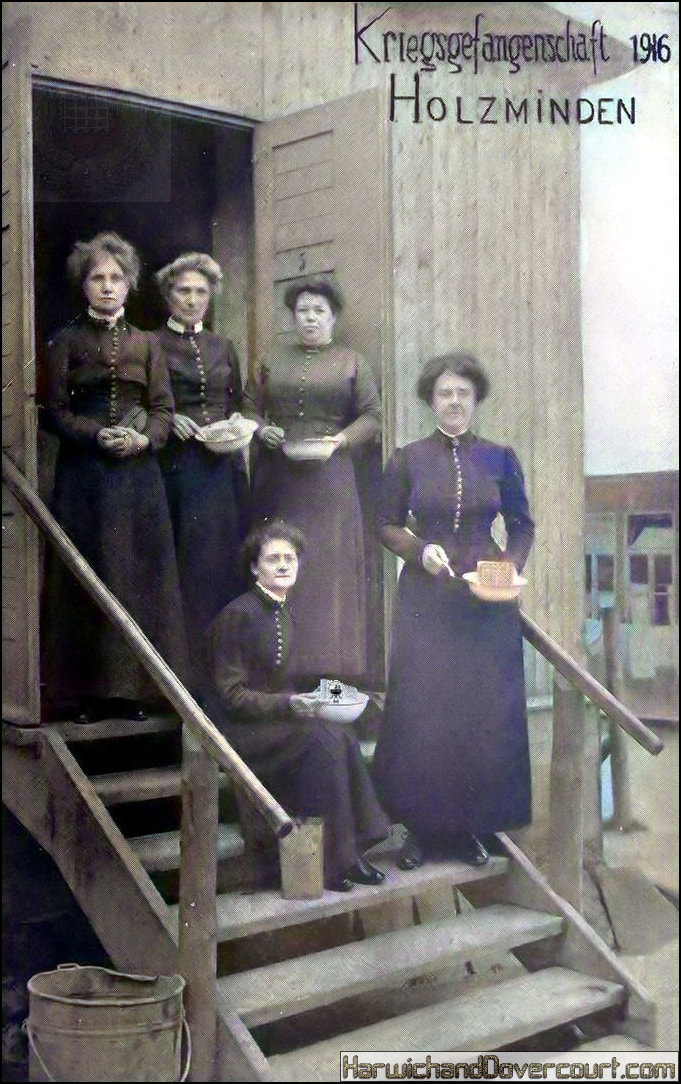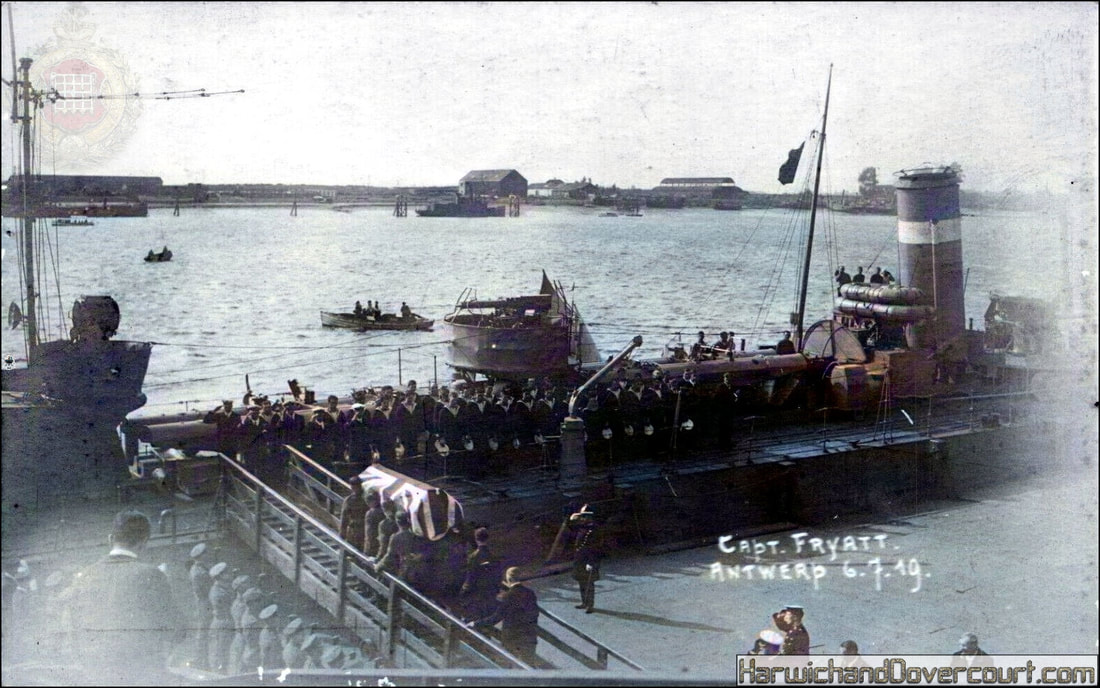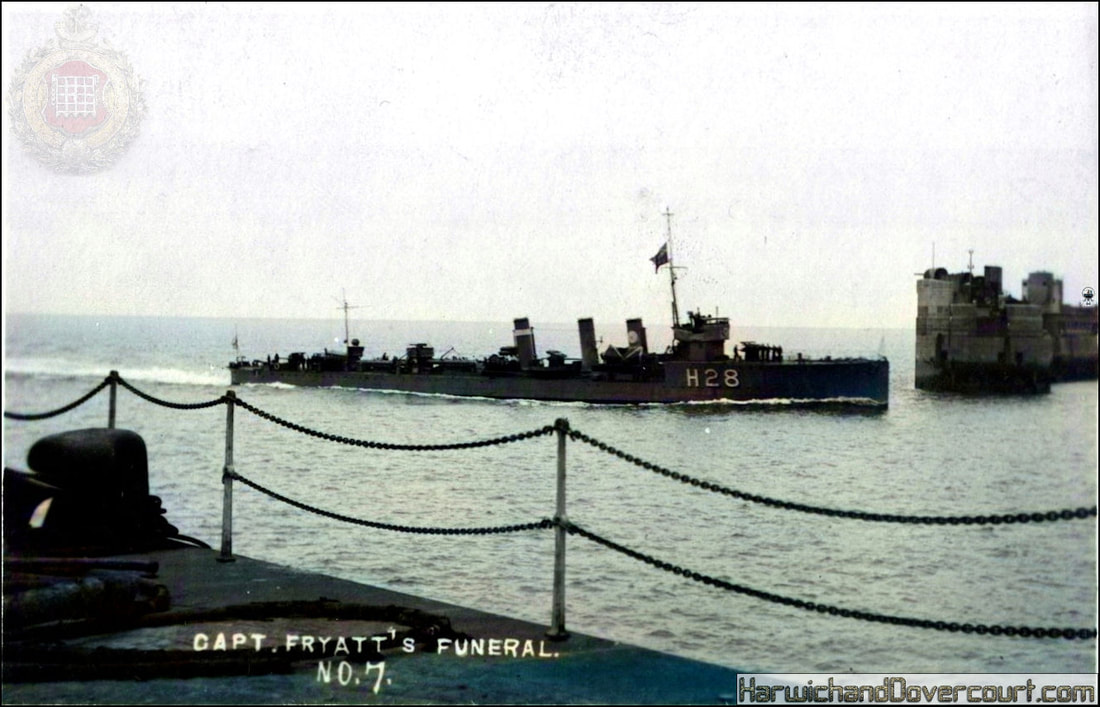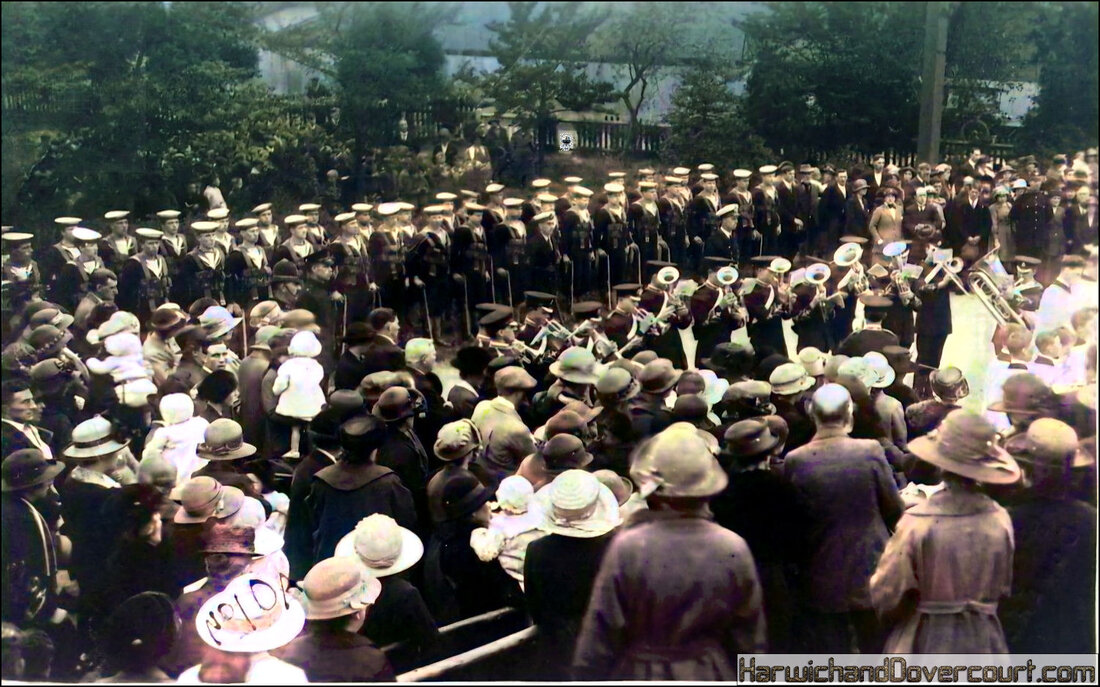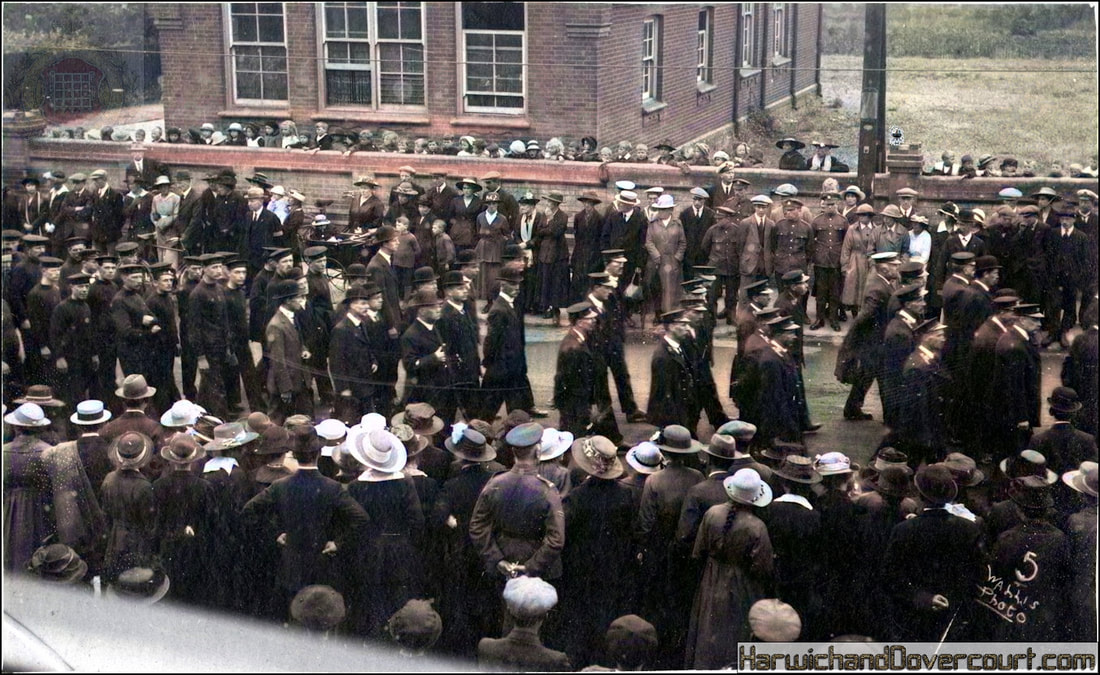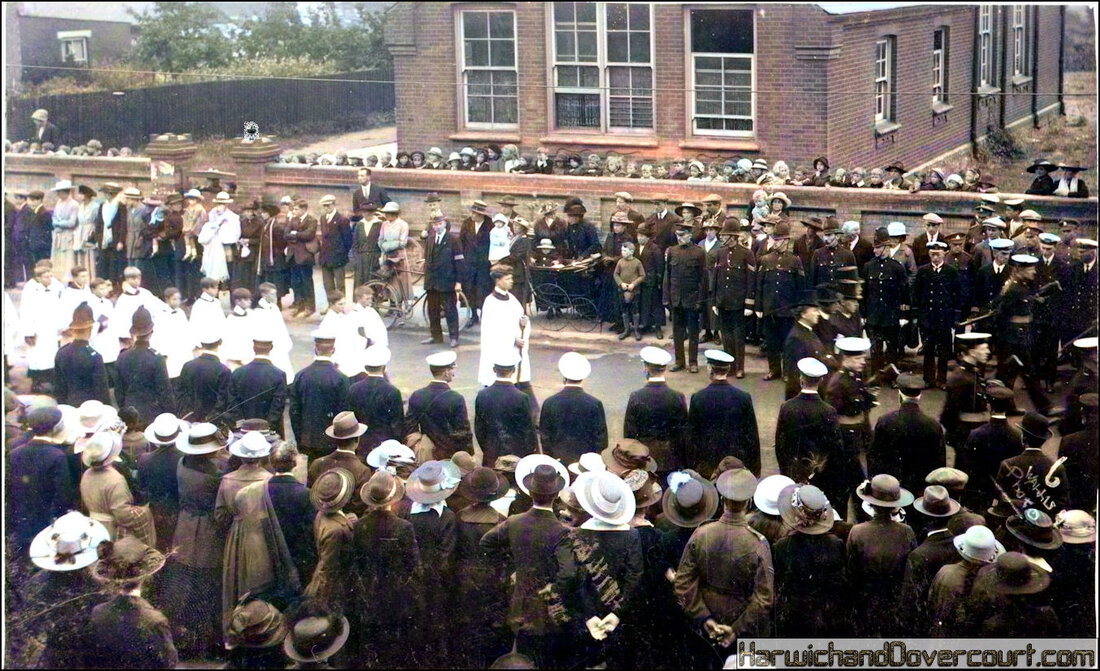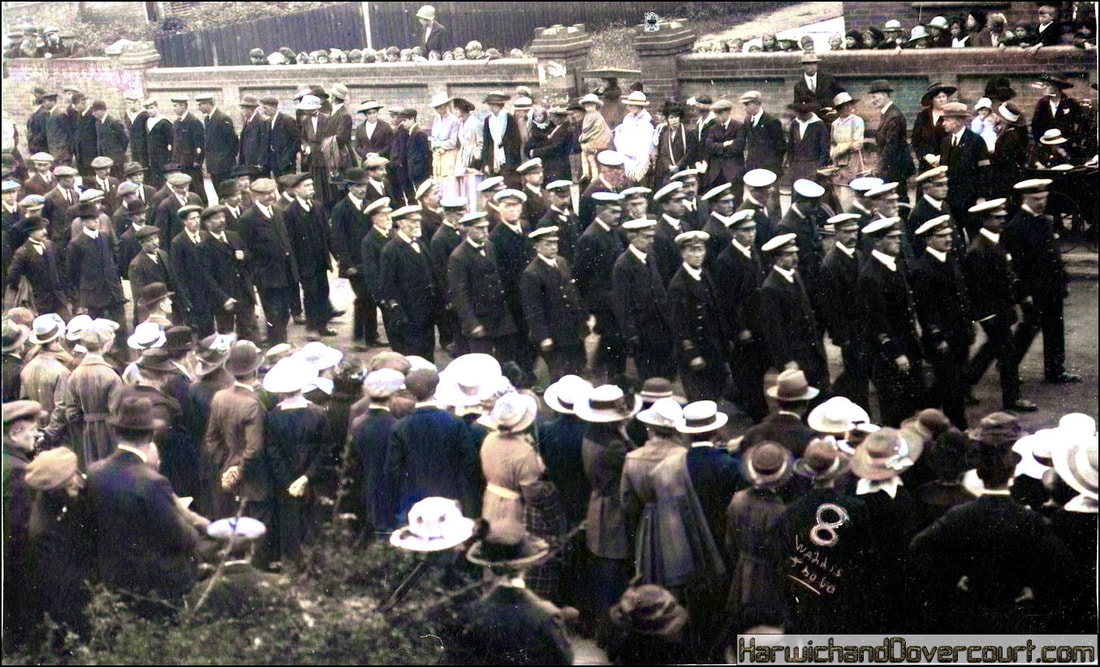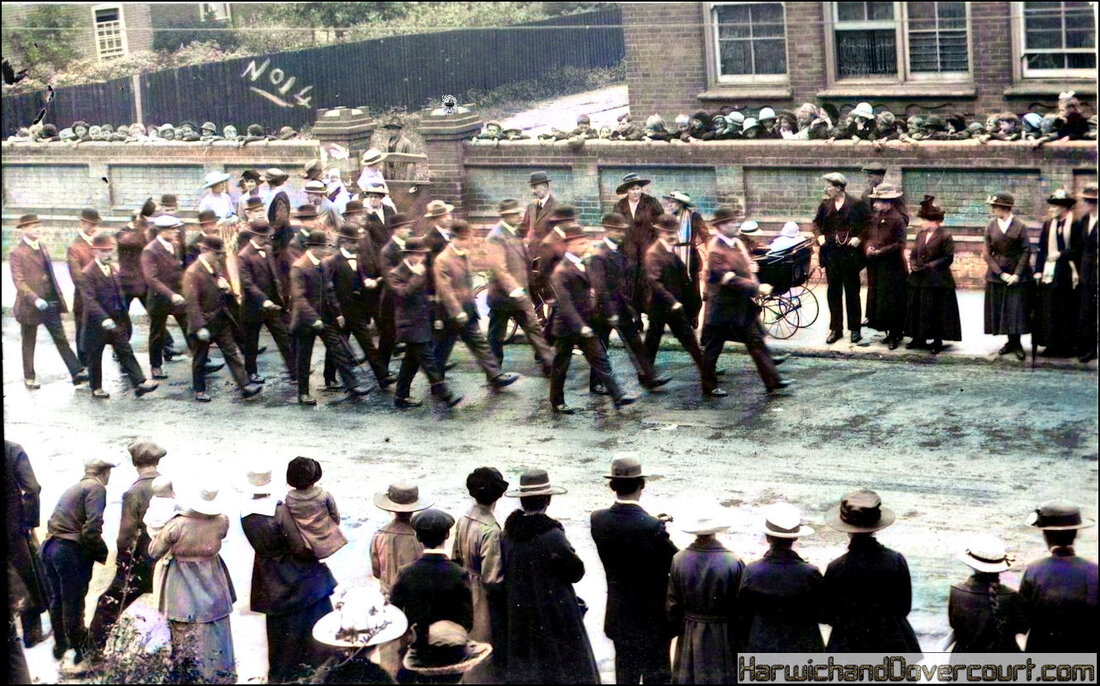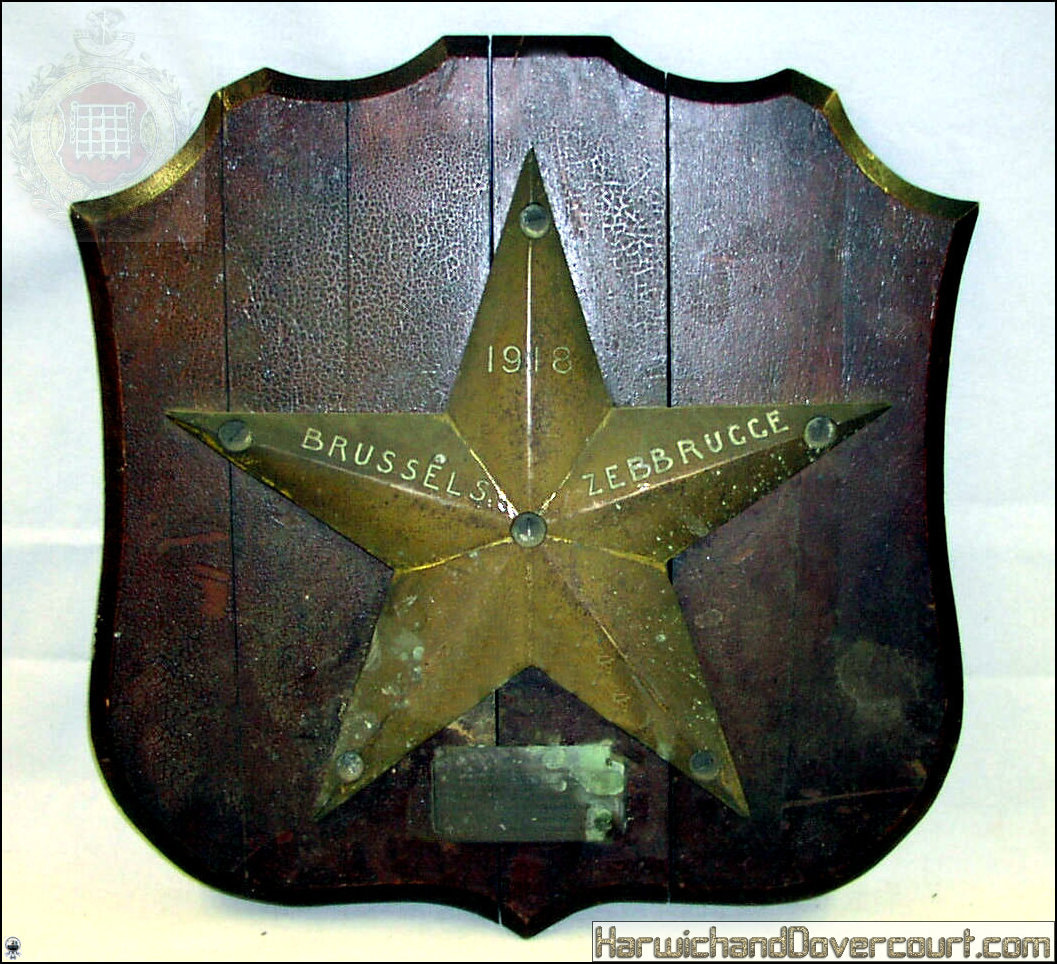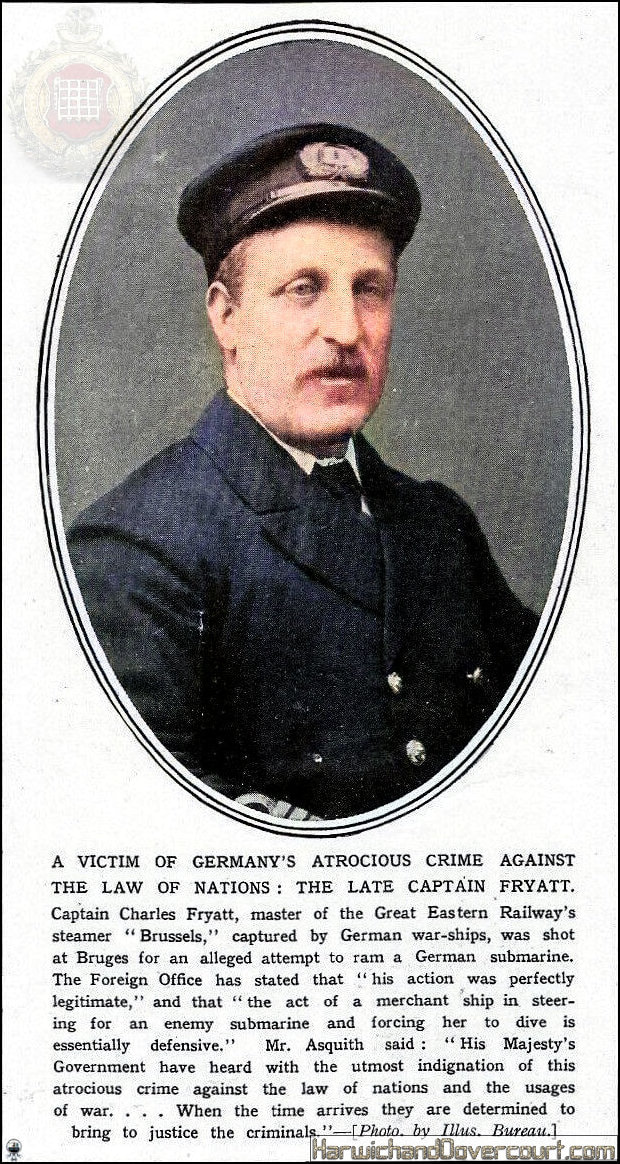~ Section 1 ~ Captain Fryatt & The S.S. Brussels ~
01 Capt Fryatt Seated - Press Photo (1915) H&D FW
Charles Algernon Fryatt (1872 -1916) At the beginning of WW1 Captain Fryatt was in command of the Great Eastern Railway steamer the SS Brussels and regularly sailing the Harwich- Rotterdam route. On 2nd March 1915, Fryatt avoided an attack on his ship, the SS Wrexham, by a U-Boat which chased the Wrexham chased for 40 nautical miles (74 km).
After being pushed to its absolute limit, the Wrexham arrived at Rotterdam to great acclaim, but with burnt funnels. The Chairman and Directors of the Great Eastern Railway Company presented Fryatt with a gold watch as a show of their appreciation of his courage and skilful seamanship.
On 28th March while commanding the Brussels, U33 ordered Fryatt to stop, and when he didn't, tried to sink the SS Brussels. The U-Boat surfaced and got into position to fire a torpedo. On seeing this, Fryatt changed direction and headed towards the U-Boat, forcing the submarine to crash dive (in accordance with orders issued by Winston Churchill to captains of merchant ships).
For this action Fryatt was awarded a second gold watch, presented by the Lords Commissioners of the Admiralty to Fryatt in recognition of the example set when attacked by a German submarine.
The SS Brussels and Captain Fryatt were now very definitely in German U-Boat commander’s sights.
On 23rd June 1916, the SS Brussels was cornered by a flotilla of German torpedo boats and escorted into the harbour at Zeebrugge then transported to Bruges. Fryatt was tried by a Court Martial on 27th July where he was found guilty and condemned to death as a 'franc-tireur' (''free-shooter'' i.e. a guerrilla fighter outside of the usual law of war).
He was executed by firing squad that same day.
After being pushed to its absolute limit, the Wrexham arrived at Rotterdam to great acclaim, but with burnt funnels. The Chairman and Directors of the Great Eastern Railway Company presented Fryatt with a gold watch as a show of their appreciation of his courage and skilful seamanship.
On 28th March while commanding the Brussels, U33 ordered Fryatt to stop, and when he didn't, tried to sink the SS Brussels. The U-Boat surfaced and got into position to fire a torpedo. On seeing this, Fryatt changed direction and headed towards the U-Boat, forcing the submarine to crash dive (in accordance with orders issued by Winston Churchill to captains of merchant ships).
For this action Fryatt was awarded a second gold watch, presented by the Lords Commissioners of the Admiralty to Fryatt in recognition of the example set when attacked by a German submarine.
The SS Brussels and Captain Fryatt were now very definitely in German U-Boat commander’s sights.
On 23rd June 1916, the SS Brussels was cornered by a flotilla of German torpedo boats and escorted into the harbour at Zeebrugge then transported to Bruges. Fryatt was tried by a Court Martial on 27th July where he was found guilty and condemned to death as a 'franc-tireur' (''free-shooter'' i.e. a guerrilla fighter outside of the usual law of war).
He was executed by firing squad that same day.
02 The Late Capt. C.Fryatt (1916) Beagles FW
03 Captain Fryatt by John T.Tussaud (1916) H&D FW
04 Captain Charles Fryatt Silk III (1918) H&D C
Captain Charles Fryatt, A Silk Embroidered Postcard
108 years ago on July 27, 1916, in Bruges, Belgium, German officials execute Captain Charles Fryatt, the former commander of the Great Eastern Railway steamship Brussels, after a German court martial found him guilty of making an attack on a German submarine. The Brussels, a British merchant vessel, was intercepted by the Germans during one of the ship's regular twice-weekly crossings from Harwich in Britain to Holland. Fryatt and his crew were arrested and taken to Ruhleben prison camp outside Berlin. Later transported to Belgium to stand trial, Fryatt was accused of acting as a "pirate"–the incident in question occurred the previous March 28, when Fryatt, his ship under attack by a German U-boat submarine, turned the Brussels around and attempted to ram the German craft. The submarine fled, and Fryatt's courageous conduct was honoured by the British Admiralty with a gold watch. The German court martial in July, however, convicted Fryatt of attempting to attack the submarine although he himself was not a combatant. In what was condemned by the British as an act of savagery, even during wartime, the Germans executed Fryatt on July 27. In terms of anti-German propaganda, Fryatt's trial and execution undoubtedly worked in the Allies favour: in the United States–neutral in the conflict as of yet–The New York Times called his death a "deliberate murder." As John Ketchum, a Canadian civilian who had been studying music in Germany when war broke out and who had been interned at Ruhleben with Fryatt and his crew, recalled: "The judicial murder of a man who had lived at Ruhleben, if only for a month, caused deep shock and anger, and brought the war home to the camp as nothing had done before." Much later, some 10 days after the signing of the Treaty of Versailles in late June 1919, Fryatt's body was returned home to Britain, where a memorial service was held in London commemorating his heroic act; the body was subsequently reburied in British soil at Dovercourt.
Silk Embroidered Postcards
Although silk embroidered postcards first appeared at the Paris Exhibition in 1900, they reached the height of popularity at the time of the First World War 1914-1918. A unique wartime industry, silk embroidered postcards were created by French and Belgian women to sell as souvenirs to soldiers posted on the Western Front. Strips of silk organza were originally hand-embroidered by women and girls in their homes or at refugee camps, but as demand increased, production was moved to Parisian factories. Batches of embroidered strips were sent for cutting and mounting onto postcards, which were made available to purchase for a few francs each. Hugely popular with British and American soldiers who bought the cards as mementos to send home to loved ones, it is estimated that some 10 million silk embroidered postcards were made.
Images found on the cards include; forget-me-not and pansy flowers, bluebirds, patriotic messages and symbols such as the flags of the allies, regimental crests and badges. These beautiful greetings would have been sent home giving no indication of what the soldiers were experiencing, sparing mothers and wives from the true horrors of war.
Because many were proudly displayed for years on mantel shelves and bedsides, silk embroidered cards are often sun-bleached and faded, or stained from exposure to coal dust and nicotine. Known also by collectors as "WW1 Silks", silk embroidered postcards are highly collectable. The most sought-after and valuable cards today are those that are relatively clean with brightly coloured silks, or display unusual or unique images.
Google Link & Postcode to Church and Memorial : CO12 4LN
108 years ago on July 27, 1916, in Bruges, Belgium, German officials execute Captain Charles Fryatt, the former commander of the Great Eastern Railway steamship Brussels, after a German court martial found him guilty of making an attack on a German submarine. The Brussels, a British merchant vessel, was intercepted by the Germans during one of the ship's regular twice-weekly crossings from Harwich in Britain to Holland. Fryatt and his crew were arrested and taken to Ruhleben prison camp outside Berlin. Later transported to Belgium to stand trial, Fryatt was accused of acting as a "pirate"–the incident in question occurred the previous March 28, when Fryatt, his ship under attack by a German U-boat submarine, turned the Brussels around and attempted to ram the German craft. The submarine fled, and Fryatt's courageous conduct was honoured by the British Admiralty with a gold watch. The German court martial in July, however, convicted Fryatt of attempting to attack the submarine although he himself was not a combatant. In what was condemned by the British as an act of savagery, even during wartime, the Germans executed Fryatt on July 27. In terms of anti-German propaganda, Fryatt's trial and execution undoubtedly worked in the Allies favour: in the United States–neutral in the conflict as of yet–The New York Times called his death a "deliberate murder." As John Ketchum, a Canadian civilian who had been studying music in Germany when war broke out and who had been interned at Ruhleben with Fryatt and his crew, recalled: "The judicial murder of a man who had lived at Ruhleben, if only for a month, caused deep shock and anger, and brought the war home to the camp as nothing had done before." Much later, some 10 days after the signing of the Treaty of Versailles in late June 1919, Fryatt's body was returned home to Britain, where a memorial service was held in London commemorating his heroic act; the body was subsequently reburied in British soil at Dovercourt.
Silk Embroidered Postcards
Although silk embroidered postcards first appeared at the Paris Exhibition in 1900, they reached the height of popularity at the time of the First World War 1914-1918. A unique wartime industry, silk embroidered postcards were created by French and Belgian women to sell as souvenirs to soldiers posted on the Western Front. Strips of silk organza were originally hand-embroidered by women and girls in their homes or at refugee camps, but as demand increased, production was moved to Parisian factories. Batches of embroidered strips were sent for cutting and mounting onto postcards, which were made available to purchase for a few francs each. Hugely popular with British and American soldiers who bought the cards as mementos to send home to loved ones, it is estimated that some 10 million silk embroidered postcards were made.
Images found on the cards include; forget-me-not and pansy flowers, bluebirds, patriotic messages and symbols such as the flags of the allies, regimental crests and badges. These beautiful greetings would have been sent home giving no indication of what the soldiers were experiencing, sparing mothers and wives from the true horrors of war.
Because many were proudly displayed for years on mantel shelves and bedsides, silk embroidered cards are often sun-bleached and faded, or stained from exposure to coal dust and nicotine. Known also by collectors as "WW1 Silks", silk embroidered postcards are highly collectable. The most sought-after and valuable cards today are those that are relatively clean with brightly coloured silks, or display unusual or unique images.
Google Link & Postcode to Church and Memorial : CO12 4LN
05 Captain Charles Fryatt Silk Memorabilia (1918) H&D C
~ 06 Capt Fryatt (Silk Cigarette Card) H&D FW ~
07 Captain Fryatt and the crew of the SS Brussels (1914) FW
Captain Fryatt and the crew of the SS Brussels in 1914.
A Great Eastern Railway Steam Ship built in 1902 Gourlay Brothers Ship Builders of Dundee, for the Harwich-Antwerp service. She was fitted with wireless telegraphy and submarine signalling.
Captured by German Naval Forces 23rd June 1916. Captain Charles Algernon Fryatt was executed and the male members of the crew interned as civilian prisoners of war. The female stewardesses were released after a few weeks.
A Great Eastern Railway Steam Ship built in 1902 Gourlay Brothers Ship Builders of Dundee, for the Harwich-Antwerp service. She was fitted with wireless telegraphy and submarine signalling.
Captured by German Naval Forces 23rd June 1916. Captain Charles Algernon Fryatt was executed and the male members of the crew interned as civilian prisoners of war. The female stewardesses were released after a few weeks.
08 SS Brussels & railway carriages in the snow at the Pier, Harwich
SS Brussels with railway carriages in the snow at the Pier, Harwich around 1912.
Built in 1902 by Gourlay Bros., Dundee (Yard No.202) for the Great Eastern Railway Co., Harwich. She was 1,380 grt and measured 285 x 34 x 15½ ft. Powered by two 3 cylinder triple expansion engines driving two propellers she was capable of 16½knots. She entered service in May 1902 on the Harwich Antwerp route.
This boat was later sunk in World War one with Captain Fryatt murdered by the Germans.
Built in 1902 by Gourlay Bros., Dundee (Yard No.202) for the Great Eastern Railway Co., Harwich. She was 1,380 grt and measured 285 x 34 x 15½ ft. Powered by two 3 cylinder triple expansion engines driving two propellers she was capable of 16½knots. She entered service in May 1902 on the Harwich Antwerp route.
This boat was later sunk in World War one with Captain Fryatt murdered by the Germans.
09 64607 G.E.R Continental Steamer Brussels (1902) FW
10 S.S. Brussels which ran aground on the shore at Felixstowe, Suffolk H&D FW
Great Eastern Railway Steamer the SS Brussels ashore at Felixstowe, Suffolk in April 1907
This was the boat that was later captained by Captain Charles Fryatt, who was murdered by the Germans during WW1 and buried in Parkeston.The Great Eastern Railway steamer Brussels went ashore on the Felixstowe side of Harwich Harbour shortly before 11 o'clock on Wednesday night during thick fog. Captain Smith, of the Brussels, in his report yesterday morning stated that the Brussels left Parkeston Quay at 10 o'clock, and when in the vicinity of Fagborough buoy ran into a thick fog. No buoys or lights could be seen, and the vessel took ground on the north side of the harbour. The position of the Brussels was not serious, as she was on soft mud, and it as expected that she would come off at high tide yesterday morning. The Great Eastern Railway steamer Clacton and the tugs Rescue, Dauntless and Foam were in attendance, and the passengers, 60 in number, were still on board. The Brussels was bound for Antwerp.
Later messages yesterday said that the passengers had been transferred to the tug Dauntless, and conveyed to Parkeston to await last night’s Antwerp boat. It was feared that a portion of the cargo would have to be removed if the Brussels was to be floated by this morning’s tide. The vessel is not seriously damaged.
This was the boat that was later captained by Captain Charles Fryatt, who was murdered by the Germans during WW1 and buried in Parkeston.The Great Eastern Railway steamer Brussels went ashore on the Felixstowe side of Harwich Harbour shortly before 11 o'clock on Wednesday night during thick fog. Captain Smith, of the Brussels, in his report yesterday morning stated that the Brussels left Parkeston Quay at 10 o'clock, and when in the vicinity of Fagborough buoy ran into a thick fog. No buoys or lights could be seen, and the vessel took ground on the north side of the harbour. The position of the Brussels was not serious, as she was on soft mud, and it as expected that she would come off at high tide yesterday morning. The Great Eastern Railway steamer Clacton and the tugs Rescue, Dauntless and Foam were in attendance, and the passengers, 60 in number, were still on board. The Brussels was bound for Antwerp.
Later messages yesterday said that the passengers had been transferred to the tug Dauntless, and conveyed to Parkeston to await last night’s Antwerp boat. It was feared that a portion of the cargo would have to be removed if the Brussels was to be floated by this morning’s tide. The vessel is not seriously damaged.
11 G.E.R. Steamship S.S. Brussels (1914) Alsace Works H&D FW
12 Lady Brussels (1925) Northern H&D FW
13 Capt Fryatt with the submerged SS Brussels
14 Capt Fryatt with the recently salvaged S.S. Brussels
15 SS Brussels & Capt Fryatt In Captivity (1916) H&D F
The S.S. Brussels captured in June 1916, with Captain C A Fryatt & First Officer W.Hartnell
This postcard may well show one of the last photographs taken of Captain Fryatt, later murdered by the Germans in 1916. Although of only poor quality, it shows Captain Fryatt, just behind First Officer W.Hartnell in the gangway of the S.S. Brussels, which was captured on the 24th/25th June 1916. Other members of the crew can be seen, as well as an armed German guard aboard the ship. The so called "court-martial" was held at Bruges Town Hall, at which he was found guilty of being a franc-tireur and sentenced to death four weeks later on the 27th July 1916.
This postcard may well show one of the last photographs taken of Captain Fryatt, later murdered by the Germans in 1916. Although of only poor quality, it shows Captain Fryatt, just behind First Officer W.Hartnell in the gangway of the S.S. Brussels, which was captured on the 24th/25th June 1916. Other members of the crew can be seen, as well as an armed German guard aboard the ship. The so called "court-martial" was held at Bruges Town Hall, at which he was found guilty of being a franc-tireur and sentenced to death four weeks later on the 27th July 1916.
16 Brussels Crew, waiting for Exchange (1918) H&D FW
17 Female prisoners in captivity from the crew of the SS Brussels (1916) H&D F
~ 18 Report from a witness at Captain Fryatt's Sham conviction & Execution ~

When Captain Fryatt was executed by the Germans, without a fair trial, there was outrage in Britain with Prime Minister Herbert Asquith deeming the execution to be 'murder'… and an 'atrocious crime against the laws of nations and the usages of war.', while King George V wrote to Mrs Fryatt expressing his abhorrence at the execution.
In Britain, the execution of Captain Fryatt was as much a cause célèbre as that of Nurse Cavell. Many world newspapers also considered the execution on a non-combatant to be an outrage, with the New York Herald calling it ''The crowning German atrocity''.
The Dutch branch of the League of Neutral States presented the Great Eastern Railway with a memorial tablet which was erected at Liverpool Street station on 27th July 1917, exactly a year after Fryatt's execution (the scrap value of Brussels was donated towards the cost).
The Great Eastern Railway awarded Fryatt's widow a pension of £250 per annum and the Government granted her an extra £100 per year pension on top of her entitlement.
Captain Fryatt was one of the very few British casualties to be repatriated for burial and he was also one of an even smaller group to be repatriated post-war. His funeral was held at St Paul's Cathedral on 8th July 1919. Hundreds of merchant seamen as well as members of the Admiralty, the Board of Trade, the Cabinet and the War Office attended.
He was finally buried at All Saints' Church, Upper Dovercourt - not far from Harwich port out of which he had sailed so many times.
In Britain, the execution of Captain Fryatt was as much a cause célèbre as that of Nurse Cavell. Many world newspapers also considered the execution on a non-combatant to be an outrage, with the New York Herald calling it ''The crowning German atrocity''.
The Dutch branch of the League of Neutral States presented the Great Eastern Railway with a memorial tablet which was erected at Liverpool Street station on 27th July 1917, exactly a year after Fryatt's execution (the scrap value of Brussels was donated towards the cost).
The Great Eastern Railway awarded Fryatt's widow a pension of £250 per annum and the Government granted her an extra £100 per year pension on top of her entitlement.
Captain Fryatt was one of the very few British casualties to be repatriated for burial and he was also one of an even smaller group to be repatriated post-war. His funeral was held at St Paul's Cathedral on 8th July 1919. Hundreds of merchant seamen as well as members of the Admiralty, the Board of Trade, the Cabinet and the War Office attended.
He was finally buried at All Saints' Church, Upper Dovercourt - not far from Harwich port out of which he had sailed so many times.
19 Captain Fryatt coffin at Antwerp 6th July 1919 H&D FW
~ No 7 ~ Captain Fryatt's coffin aboard the destroyer HMS Orpheus at Dover (1919) H&D ~
In July 1919, following the end of the First World War, the body of Captain Fryatt was exhumed from the cemetery near Bruges and returned to Britain aboard the destroyer HMS Orpheus. The coffin was draped in the Union flag and guarded by four bluejackets with fixed bayonets. Following its arrival at Dover, the coffin was transported by rail to Charing Cross Station. It was then solemnly placed on a gun carriage and provided with a naval escort for the short journey to St Paul’s Cathedral for a state funeral. Following the service, attended by the Prime Minister and War Cabinet, the funeral cortege led by drummers from the Royal Marines made its way to Liverpool Street Station. Thousands of people crowded the pavement many of whom were merchant seamen and their families who wished to pay their last respects.
~ 20 #09 Captain Fryatt Funeral Procession at Dover, with the the destroyer HMS Orpheus arriving from Antwerp. (1919) H&D ~
21 Captain Fryatt Funeral, Dovercourt #10A (1919) Wallis FW
22 #05 Captain Fryatt Funeral, Dovercourt (1919) by Wallis H&D FW
Captain Fryatt funeral procession, Dovercourt, July 7th 1919
At the end of WW1, the bodies of only three heroes were ever brought back to England and given state funerals; those of the nurse Edith Cavell, the Unknown Warrior and British Merchant Navy Captain Charles Algernon Fryatt.
Charles was executed by the Germans in 1916, for attempting to ram a U-boat, which was about to torpedo his ship, the "SS Brussels". Charles referred to as "The Martyr of Bruges" simply tried to save his passengers, crew and ship, by attempting to ram a German submarine, he was later captured off Zeebrugge & sent to an internment camp near Berlin, before being returned to Bruges to be court martialled and sentenced to death.
At the end of WW1, the bodies of only three heroes were ever brought back to England and given state funerals; those of the nurse Edith Cavell, the Unknown Warrior and British Merchant Navy Captain Charles Algernon Fryatt.
Charles was executed by the Germans in 1916, for attempting to ram a U-boat, which was about to torpedo his ship, the "SS Brussels". Charles referred to as "The Martyr of Bruges" simply tried to save his passengers, crew and ship, by attempting to ram a German submarine, he was later captured off Zeebrugge & sent to an internment camp near Berlin, before being returned to Bruges to be court martialled and sentenced to death.






